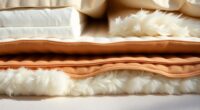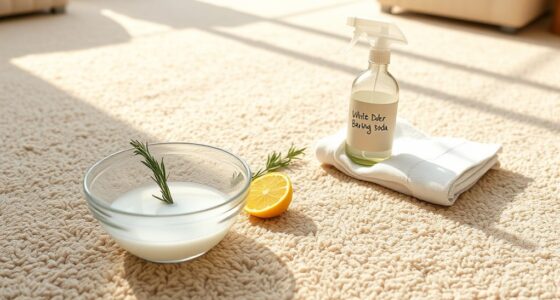To remove tough stains in minutes, act quickly. Start by blotting the stain to absorb excess liquid. Rinse it with cold water from the backside to prevent setting. Apply a stain remover directly to the area and let it sit. For stubborn stains, soak the fabric in a mix of lukewarm water, dish soap, and white vinegar for about 15 minutes. Use a small brush to tackle dried stains. For specific stains, you can use unique solutions, like baking soda for oil or vinegar for coffee. There's more to discover about effective techniques for tackling various stains!
Key Takeaways
- Blot stains immediately with a paper towel and flush with cold water to prevent setting.
- Apply a stain remover or a mixture of dish soap and vinegar directly onto the stain.
- Use a small brush to gently scrub dried stains, enhancing effectiveness with natural agents like white vinegar.
- Soak stubborn stains in a solution of lukewarm water and detergent for 15 minutes before rinsing.
- For specific stains, use targeted methods such as baking soda for oil or cold water for blood stains.
Immediate Actions for Stain Removal
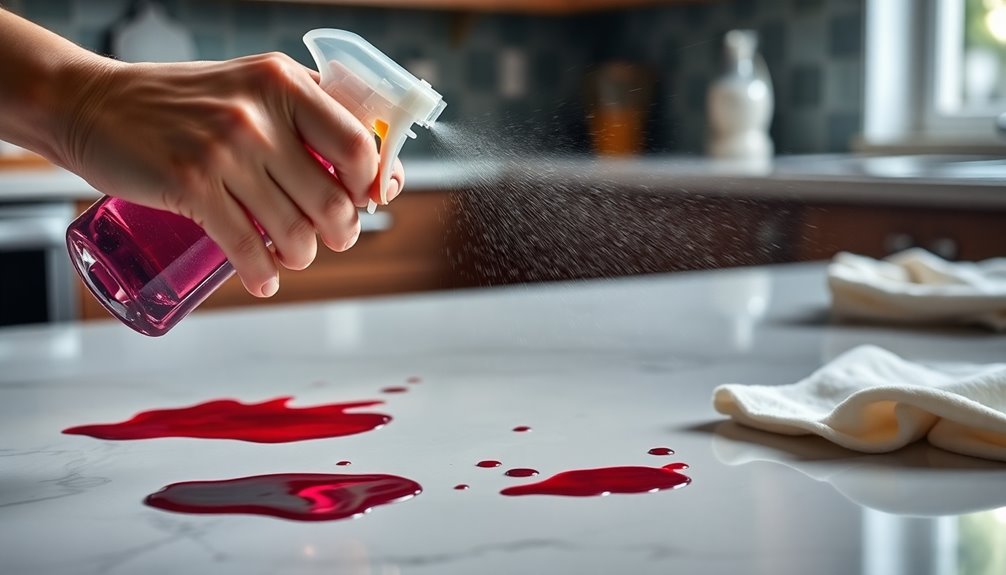
When you spill something or notice a stain, acting quickly can make all the difference. Start by blotting the stain immediately with a paper towel to absorb as much as possible—don't rub!
Next, flush the fabric with cold water from the backside to prevent the stain from setting. Apply a stain remover directly to the affected area.
For stubborn stains, soak the item in a solution of lukewarm water, liquid dish soap, and white vinegar for 15 minutes. It's also important to remember that a combination of techniques may be necessary for effective stain removal. Always test your stain remover on an inconspicuous area first, and check the fabric type to ensure it's safe.
Remember to avoid hot water, as it can make stains worse. Repeat the process if the stain doesn't come out completely.
Physical Techniques to Tackle Stains
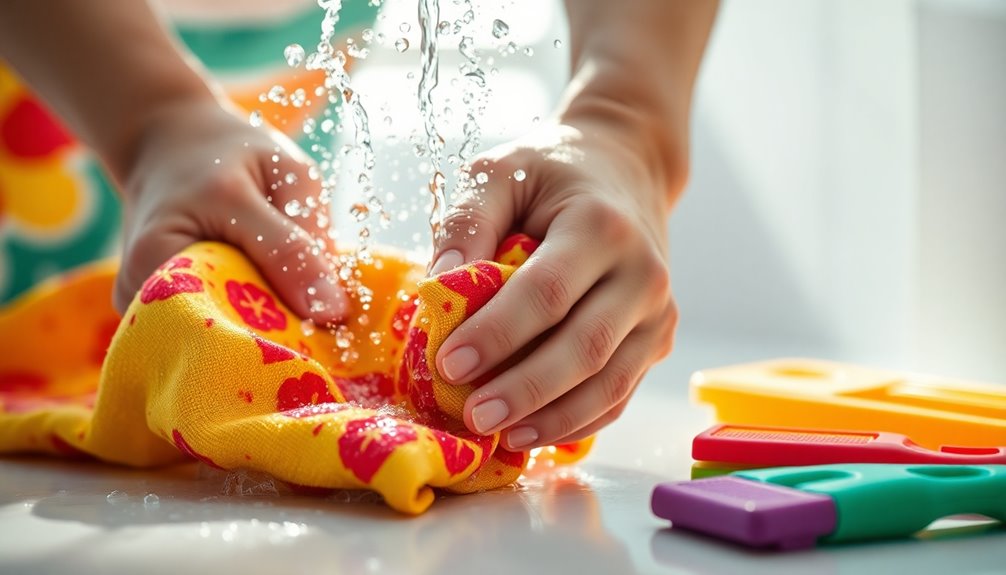
To effectively tackle tough stains, you can employ various physical techniques that help lift the stain without damaging the fabric.
Start by using a small, stiff-bristled brush to gently remove dried stains. Hold a clean sheet of paper next to the stain to catch debris as you brush.
For fresh stains, flush the area with an eyedropper or plant mister, placing an absorbent pad beneath to soak up excess liquid. Using natural stain removers like white vinegar can enhance the effectiveness of this process.
Pretreat stains by applying liquid detergent or pretreating spray directly to the area, rubbing it in gently.
For stronger fabrics, tamp the stain with a spoon or brush, keeping it moist and flushing with a dry-cleaning solvent until the stain lifts.
Repeat as needed, then allow the fabric to dry.
Effective Chemical Agents
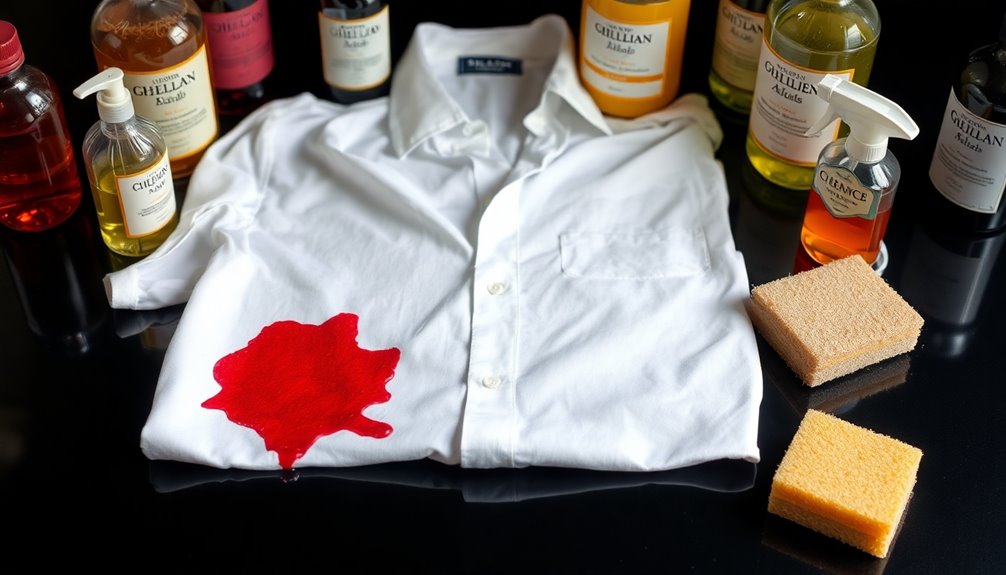
Effective chemical agents play a crucial role in removing tough stains, as they target and break down the stain's composition.
Solvents like Bio-Solv dissolve chemical stains by mimicking their molecular structure, making them particularly effective for oil-based stains. Additionally, oil-based stains often require more intensive cleaning methods compared to other types.
Surfactants, such as ProTool Sticky, coat and lift stains by reducing surface tension, working well on both water-based and oil-based stains.
Enzymes in cleaners like G-Force break down organic stains by digesting fats, also eliminating odors.
Lastly, oxidizers, including bleach and hydrogen peroxide, lighten stains by breaking down color-causing molecules.
Each of these agents offers unique properties, ensuring you have the right tools to tackle even the toughest stains effectively.
Pre-Treatment Strategies

How can you increase your chances of removing tough stains? Act quickly! The sooner you treat a stain, the better your chances of complete removal.
Start by blotting the area with a clean cloth to absorb excess liquid—don't rub, as that can spread the stain. Always test any stain removal method on a hidden area first to avoid damage.
Follow the care labels on your fabrics, and use cold water to rinse most stains, as hot water can set them. For effective pretreatment, common household items like white vinegar, baking soda, and dish soap can work wonders. Additionally, pretreating stains early can significantly boost your chances of complete stain removal. Maintaining a clean home can also help prevent future stains from becoming embedded in your fabrics.
Lastly, consider using your regular laundry detergent or specialized products for tougher stains.
Specific Stain Solutions
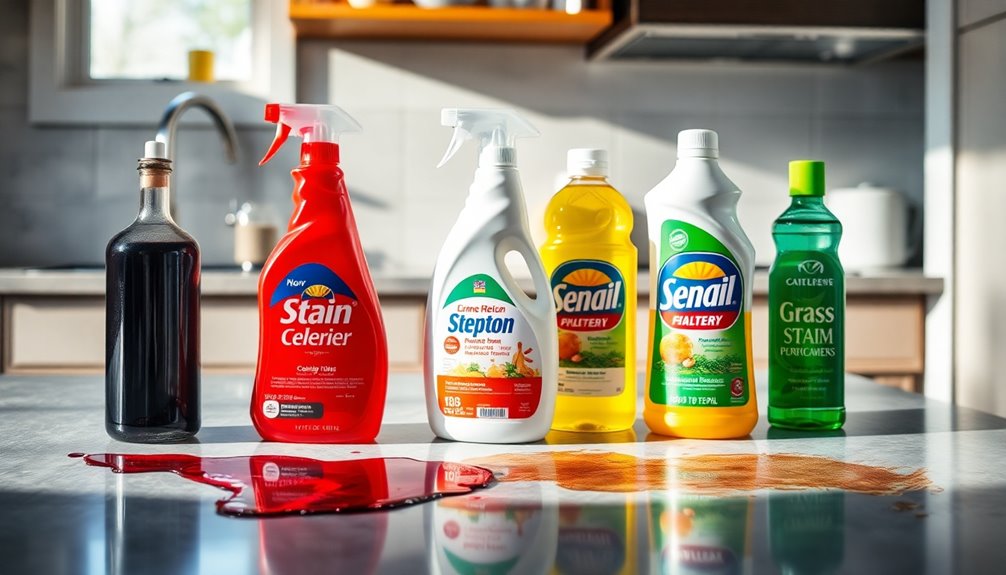
When you encounter tough stains, knowing the right approach can make all the difference in restoring your fabric.
For oil-based stains, remove excess oil with a dull knife, blot with a paper towel, then apply baking soda and dish soap before laundering. Act quickly to treat stains; early action increases removal success.
For coffee, flush with cold water, rub in detergent, and soak if necessary.
Red wine? Blot, soak in OxiClean, and apply stain remover if needed.
For paint, remove excess, flush with warm water, and treat with detergent.
Blood stains require soaking in cold water and using stain-releasing detergent.
Grease stains respond well to dish soap and warm water.
Sweat stains benefit from pre-wash removers and baking soda paste.
Follow these steps for successful stain removal!
Frequently Asked Questions
How Can I Prevent Stains From Setting in the First Place?
To prevent stains from setting, act quickly when spills occur.
Blot the stain with a clean cloth instead of rubbing, and use cold water to keep it from setting.
Avoid placing stained items in the dryer or near heat sources, and store them separately.
Pre-treat fabrics with a protector and be careful during meals to minimize spills.
Familiarize yourself with fabric care instructions for effective stain prevention.
Are There Any Home Remedies for Tough Stains?
Yes, there are effective home remedies for tough stains!
You can start with white vinegar mixed with equal parts water to tackle fresh stains.
For tougher spots like blood or grass, try hydrogen peroxide.
If you're dealing with grease, sprinkle borax or cornstarch on the stain to absorb it.
Just remember to let these remedies sit for a bit before rinsing and laundering as usual for the best results!
How Do I Properly Wash Stained Fabric After Treatment?
To properly wash stained fabric after treatment, start by rinsing it thoroughly to eliminate any leftover detergent.
Blot the stained area with a clean cloth to absorb excess moisture.
Choose the right wash cycle and temperature based on the fabric-care label, avoiding the dryer until you're sure the stain's gone.
If it persists, repeat the wash.
Always check your garment for any remaining stains before drying to prevent setting them in.
Can Some Stains Be Removed After They Have Dried?
Did you know that nearly 70% of stains can still be removed even after they've dried?
While it's easier to tackle stains right away, you can still treat dried stains effectively.
Start by rehydrating the stain with cold water and a suitable cleaner. Blot it gently, avoiding any rubbing.
Depending on the stain type, you might need to repeat treatments or use specialized products to achieve the best results.
What Fabrics Are Most Resistant to Staining?
When you're looking for fabrics resistant to staining, consider FibreGuard, which offers durability and easy cleaning.
Sunbrella's high performance suits both indoor and outdoor settings.
Crypton provides soft textures ideal for home use, while Easy Clean fabrics are designed for quick wipe-downs without chemicals.
Lastly, Warwick's Halo fabric range gives you a huge selection of stain-resistant options at various price points.
These choices will help you maintain a cleaner, more stylish space.
Conclusion
In just a few minutes, you can conquer even the toughest stains with the right approach. Remember, stains may seem like stubborn foes, but with your newfound knowledge and a bit of determination, you're equipped to reclaim your fabrics. Think of each successful removal as a small victory; it's not just about cleanliness but restoring beauty to your belongings. So roll up your sleeves and tackle those stains—after all, every fabric deserves a second chance!

